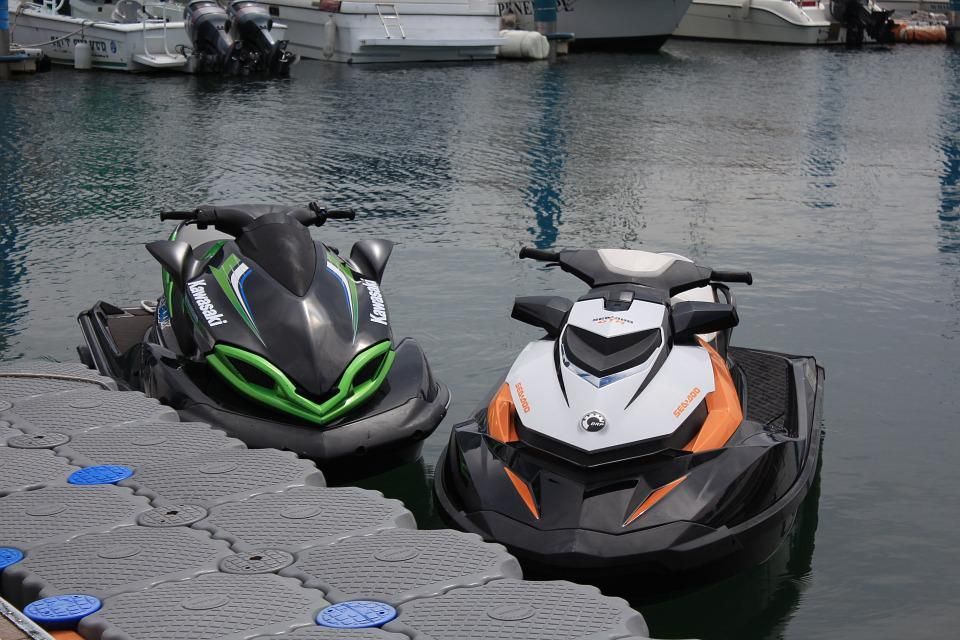
How to Winterize a Jet Ski
Image Credit: IATE CLUBE GUAÍBA ICG / flickr
Winterizing is the process of preparing your jet ski for long-term storage in the winter months. Proper winterizing helps to ensure your personal watercraft (PWC) remains in top form throughout the off season, so that it's ready to ride again next summer.
Why You Need to Winterize Your Jet Ski
Jet skis are built to be used on the water in the summer. Without adequate preparation, winter weather can be damaging to the exterior finish and inner workings of the vehicle. The biggest risk is that water will be trapped in your PWC over the winter, where it could freeze, expand, and damage the fuel lines and engine block.

Image Credit: pm72330 / Pixabay
What If It Doesn't Get Cold Where I live?
Even if there isn't a risk of freezing where you live, preparing your jet ski for long-term storage is a sensible precaution. Regularly cleaning the hull, maintaining the engine, and draining your PWC reduces the accumulation of grime or salt residue, preventing corrosion and ensuring your jet ski keeps functioning well for years to come.
Supplies You Need to Winterize a Jet Ski
The following supplies are needed to fully winterize your jet ski:
- Car safe soap
- Rags and cloths
- One or two-gallon buckets
- Finishing wax
- Fogging spray oil
- Siphon pump (if draining fuel)
- Fuel stabilizer
- RV antifreeze
- Garden hose
- Flushing adaptor (some models)
- Tarp or jet ski cover
Steps
Winterize the Jet Ski Exterior
1. Wash your jet ski hull
Thoroughly scrub the hull of your jet ski with water and car safe soap. Make sure to remove all grime, algae, and salt residue, if you use your jet ski in salt water, to reduce the chance of corrosion over winter.
2. Rinse the hull with clean water
Using a hose or buckets of water, give the whole hull a rinse to ensure there are no soap suds left anywhere on the body.
3. Wipe down the seat and handles
Wipe down all furnishings and exterior mechanics with a damp cloth. Be careful not to scrub mechanics thoroughly as this may remove essential lubrication and affect performance.
4. Leave your jet ski to dry
After washing the exterior, leave the jet ski to dry completely. Open any storage compartments to allow air to move freely and release moisture.
5. Wax the hull
Apply finishing wax to the hull to protect it against moisture build up while in storage.
Winterize the Jet Ski Engine
Jet skis suck in water to help cool the engine. When winterizing your jet ski, it's essential that you get drain water from the engine. Water expands when it cools and freezes, so if there is water in your jet ski during the winter there is a good chance it will expand and damage the engine.
1. Tilt the jet ski
Using a jack or a trailer, tilt the jet ski so that the bow (front) is higher than the stern (back) and secure it in this position.
2. Run the engine to expel water
Pull the throttle once or twice to engage the engine in 20 to 30 second increments. Continue running the engine in short bursts until the jet ski stops expelling water.
3. Lubricate the engine
Use fogging oil spray to lubricate the engine's moving parts, such as the steering nozzle pivot points, and the brake and reverse mechanisms. Carefully remove the jet ski's air filter and spark plugs and lubricate the carburetor and spark plug cylinders. Once all parts have been lubricated, replace the spark plugs and air filter. Lubricating the engine helps to remove all traces of water.
4. Wipe down excess oil with a rag
Make sure not to leave any excess oil sitting on the engine over long periods of time.
Winterize the Jet Ski Exhaust System
If you live in a cold climate and plan to store your jet ski outdoors during the winter months, winterizing the exhaust system is essential for keeping your engine in good condition.
1. Drain or fill up the tank
When storing your vehicle, it's important that the fuel tank is either topped up or empty. Some storage facilities have rules against storing vehicles with gas in the tank, so make sure to check before topping up. If you're storing your jet ski on personal property, you can decide based on how much fuel you have left in the tank.
To drain your jet ski of fuel, insert a siphon pump into the fuel tank and drain the gas into a gas container, ready to use next summer.
2. Put stabilizer in your gas tank
Regardless of whether you are storing your jet ski with the tank full or empty, adding fuel stabilizer to the tank prevents fuel or fuel residue from becoming sticky and affecting a vehicle engine when out of use for long periods of time. Adding stabilizer before flushing the exhaust ensures that the fuel lines are flushed properly.
3. Create a mixture of antifreeze and water
In a bucket, mix equal parts antifreeze and water. Around a gallon of mixture is enough for most regular sized PWCs. Use RV antifreeze rather than regular automotive antifreeze as it is cheaper, non-toxic, and can be disposed of as you would regular wastewater.
4. Hook up a hose or pump to the jet ski flush outlet
You can use a regular garden hose or any other kind of automotive hose. Some models of jet ski require a special flushing adaptor to connect a hose to the flush outlet. Consult your PWCs manual for how to connect to the flush adaptor. Securely connect a funnel to the other end of the hose.
5. Turn the engine on
Before you start flushing, make sure your engine is on. This makes sure the antifreeze mixture travels fully through the engine. Do not attempt to flush a jet ski engine while it is not running.
6. Pour the antifreeze mixture into the funnel
Make sure you are holding the funnel and hose above the height of the jet ski, so the mixture travels fully down the tube. You should see the mixture come out of the exhaust. You may want to position another bucket under the exhaust to collect the waste mixture. Once you can see the mixture is passing through the engine correctly, pour all the mixture into the funnel.
7. Avoid running the engine for more than a minute at a time
Run the engine in short bursts while flushing. If you have poured the antifreeze mixture and nothing has come out after 20 seconds, turn off the engine and let it cool for 15 minutes. Check that the jet ski is tilted properly on the trailer or stand. If the problem persists, contact a mechanic to help diagnose the issue.
Preparing a Jet Ski for Winter Storage
All the above steps are good practice for when you are leaving your jet ski for a long period of time. If you are storing your jet ski for the winter, either in a garage or a storage facility, there are some other steps to ensure your vehicle remains in top condition.
1. Drain or fill the tank and add stabilizer, as described above
Whether you flush the exhaust system or not, follow the steps above for filling or draining the tank and adding fuel stabilizer.
2. Remove and charge your battery
If you leave the battery in your jet ski over the winter, you will probably find a dead battery next summer. Avoid this by removing the battery and putting it on charge when not in use. Some storage facilities allow for trickle charging on site, if not, plug it in at home.
3. Change the oil
Old oil can become thick and clog up the engine. Add new oil and perhaps a new oil filter to avoid this problem.
5. Cover your jet ski
To keep your jet ski's exterior in the best possible condition, cover it with a tarp or a fitted jet ski cover.
What About the Trailer?
Don't forget to safely store the trailer you transport your jet ski on during the winter as well. Make sure your trailer body is wiped down, the tire pressure is topped up and the bearings are greased.
FAQ About Winterizing Jet Skis
- When do I winterize a jet ski?
After your last ride of the season, or before temperatures reach 40F.
- How much does it cost?
Winterizing using the methods above should cost between $20 and $200, depending on the steps taken and supplies chosen. Some dealerships offer winterization services that cost between $100 and $600.
- Can I keep my jet ski outside/on the dock?
Keeping your jet ski outside during the winter exposes it to the elements, creating a bigger risk of damage. If you are storing your jet ski on a dock, make sure no part of the vehicle is in the water.
- Do I need to winterize my jet ski if I keep it in my garage?
Winterizing your jet ski prepares it for the cold weather of winter. If your garage is heated and protected from the elements, you may not need to flush the exhaust with the same thoroughness described above. However, following all the steps above every winter is the best way to make sure your PWC remains in good condition.
Updated